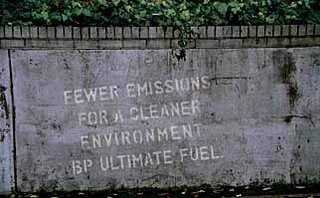

What are all the hip kids doing these days? Marketing their products on the streets, generating word of mouth, of course!
Using pressure washers and urban soot, there has been a trend to "clean up" dirty city walls and sidewalks by adding advertising artwork. The most infamous are Vision Media's campaign (top right) for the 2006 Lotus Awards and O&M/London's Ultimate Fuel promotion (bottom right) for BP.
As with most art, even etching commercial messages into dirt had its origins somewhere. This trend is usually linked with British graffiti artist Moose and his chemically etched Smirnoff reverse stencils (for which he was promptly disparaged and fined, mind you).
It is brilliant that people are finding ways to gain attention while still bringing to light an issue of social consciousness. Those city bits are pretty filthy. Hopefully, local governments and homeowners associations will find cleanliness to be a higher virtue than homogenicity.